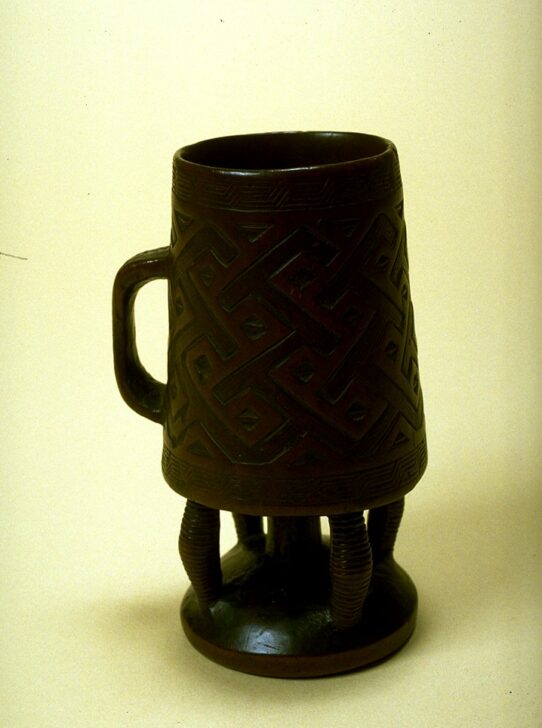Cup
Kuba

Description
Palm wine, made from raffia palm trees, is a popular beverage among Kuba men and women. Elaborately decorated cups, however, are generally reserved for the ceremonial drinking of palm wine. The motifs found on many of these cups come from an extensive Kuba decorative vocabulary, which is used on many Kuba art forms, including sculpture and textiles. Decorated wooden palm wine cups were items of high prestige until the twentieth century when their use diminished due to the increased monetary value placed on the cups by Western collectors and the introduction of metal and plastic replacements.
Subject Matter:
Kuba artists applied their bold and sophisticated surface designs to both ceremonial and everyday objects alike. Objects such as drums, boxes, stools, backrests, knives, swords, bangles, wisdom baskets, staffs and fly whisks were typically reserved for the king and his courtiers. However, these objects, in addition to cups, rubbing oracles, pipes, combs, drinking horns, ritual spoons, and scepters, also served specific religious and ceremonial functions, or were simply everyday objects for common use.
Ornately designed cups were often created as a form of competition among title members. The cups were additionally used to drink palm wine. Palm wine, made from raffia palm trees, was a popular beverage among Kuba men and women. Additionally, elaborately decorated cups were generally reserved for ceremonial purposes.
The geometric patterns on this particular cup are similar to patterns found on Kuba textile, basketry, sculpture, and female body scarifications. The diamond pattern on this cup is created through a crossing and interlocking of lines. A double crossing can possibly be considered a reference to Woot, the mythical founder of the Kuba, whose mother invented mat weaving.
References:
Daniel Biebuyck, The Arts of Zaire, 1985
Georges Meurant, African Textiles from the Kingdom of Kuba, 1986
Roy Sieber, African Textiles and Decorative Arts, 1972
Jan Vansina, The Children of Woot, 1978
Physical Description:
A vertically positioned cup with handle. There are five legs underneath the cup attached to a circular base. The cylindrical portion is carved with geometric intersecting lines forming a diamond pattern. At the rim and base of the cylindrical portion of the cup are thin strips of horizontally positioned crossing lines that wrap around the cup.
Usage Rights:
If you are interested in using an image for a publication, please visit https://umma.umich.edu/request-image/ for more information and to fill out the online Image Rights and Reproductions Request Form.